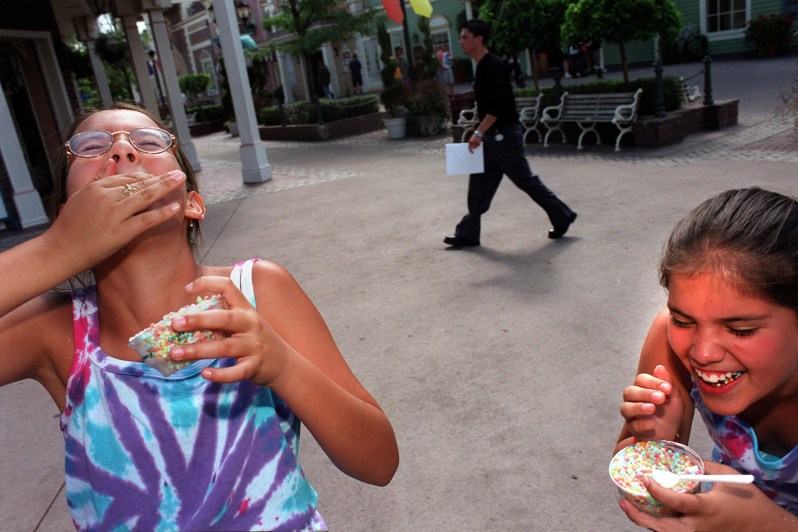A legendary treat among ’90s kids (largely because it had to be specially ordered from a catalog and couldn’t be found at grocery stores), the foil-wrapped blocks of magic known as “astronaut ice cream” may have represented the ultimate special occasion during our childhoods … but it’s rare to find a grown-ass adult who still eats these novelties (or their close cousins, the amusement-park concession icons called Dippin’ Dots) on a regular basis.

But could there be more upscale ways to utilize these uniquely textured desserts? According to some pro pastry chefs, the answer is yes. Read on for a full primer on freeze-dried and flash-frozen ice creams and a couple of specific suggestions for giving astronaut ice cream a high-end makeover.
What is the difference between “astronaut ice cream” and flash-frozen ice creams (like Dippin’ Dots)?
During astronaut ice cream’s popularity peak, many consumers used that catchy term pretty loosely. Yes, “astronaut ice cream” did refer to the solid bricks of ice cream that were marketed as desserts served to actual NASA employees (although that myth now finds itself thoroughly debunked). However, similar products — like Dippin’ Dots, the semi-solid ice cream pellets — also laid claim to the “astronaut ice cream” moniker, at least in colloquial terms.
So what’s the deal? Is “astronaut ice cream” a different product than Dippin’ Dots and its ilk? In the simplest terms: Yes, absolutely. The version made by Astronaut Foods and other astronaut-ice-cream purveyors involves a freeze-drying process, which removes all moisture from the ice cream and transforms it into an item that’s completely shelf stable. Astronaut Foods claims that its ice cream has a “three-year shelf life, more than enough time to travel to Mars and back.”

Dippin’ Dots, on the other hand, isn’t officially “astronaut ice cream” because it’s not freeze-dried and can’t stay intact at room temperature for any period of time (anyone who’s ever carried a Dippin’ Dots bowl around a Six Flags amusement park at the height of summer can attest to that). Instead, according to its website, Dippin’ Dots consists of “flash frozen beads of ice cream that, because frozen stuff can still melt, are stored at extremely cold temperatures.” While flash freezing does remove some water content from the ice cream, it doesn’t completely dehydrate, so melting can (and will) still occur.
If you want to make a room temperature-stable ice cream cake or pastry, then the freeze-dried stuff is your best friend.
Perhaps the biggest downside to an ice cream cake involves that dessert’s precarious lifespan. Once you remove the cake from the freezer and serve it on a table at room temperature (or, if you’re a real risk-taker, outdoors on a warm July afternoon), you’re operating on borrowed time.
To avoid this tragic fate, pastry chef Azeez Yusuf of Sugar Factory River North likes to swap out conventional ice cream for a freeze-dried equivalent, in both cakes and in other pastries and desserts that benefit from the addition of temperature-stable ice cream. “Freeze-dried ice cream’s unique texture and composition allows it to be used in more versatile ways than traditional ice cream. It can be used to make room temperature-stable ice cream cakes, [and it can also be] used as a filler for chocolate spheres and candies. [For example,] a chocolate cigar stuffed with dessert filling such as mousse/pastry cream [and] dipped in freeze-dried, powdered red velvet and vanilla ice cream at the tip and [served] surrounded with freeze-dried powdered charcoal ‘ash’ ice cream,” Yusuf suggests.
Use the freeze-dried ice cream capsules to upcycle the sprinkles on an ice cream sundae.
While most astronaut ice cream comes in the form of an edible “brick” (often in Neapolitan flavors) or an ice cream sandwich, some companies produce freeze-dried astronaut ice cream capsules, which are very similar to Dippin’ Dots, albeit a shelf-stable rendition. These freeze-dried treats work beautifully as additions to a typical “sprinkle” garnish on an ice cream sundae, according to corporate executive chef David Mullen of Davidson Hotels and Resorts: “I suggest a red velvet cake ball hot fudge sundae, made the classic way with whipped cream, a cherry, and wafer cookies. [But then, I’d] add strawberry freeze-dried ice cream (like this one) to the chocolate sprinkles [topping off the sundae], and voila! A delicious, elevated dessert.”


